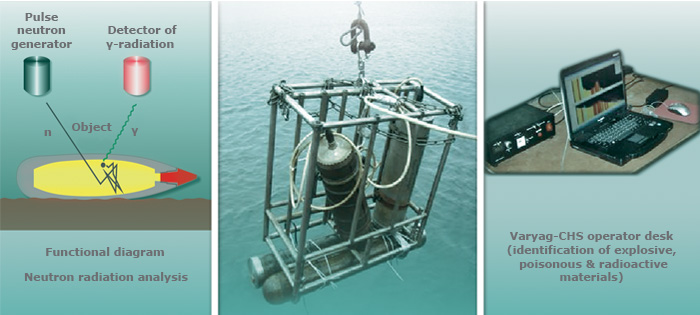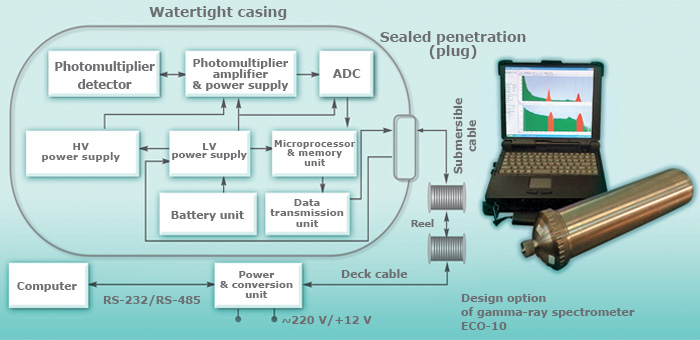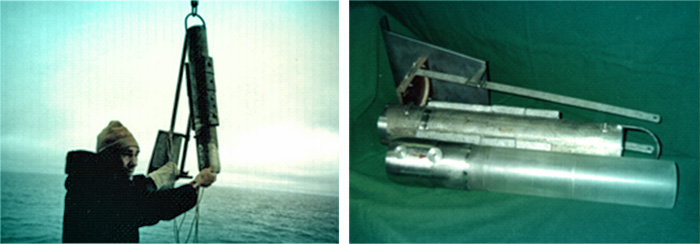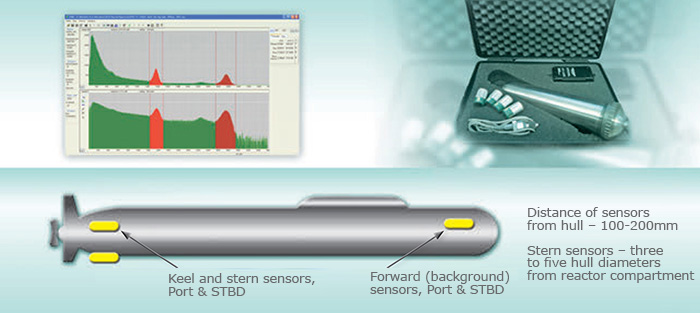Instrumentation and equipment have been delivered for ensuring environmental safety of marine structures and radiation stealth of nuclear submarines under design.

Water Chemical Laboratory – 3 M (PVHL)
A water chemical lab along with spare modules has been delivered to the Indian Navy.
VARYAG-CHS system
Configuration:
Onboard equipment:
Outboard equipment:
Detection capabilities:
| Nitrogen-containing explosives (RDX type materials) | from 3 kg |
| Sulfur-containing poisons (mustard type substances) | from 5 kg |
| Volumetric activity of gamma-emitting radionuclides dissolved in sea water | from 500 Bq/m³ (137Cs) |
| Analysis time | 10 minutes |
| Range | up to 30 cm |

RPN 09 is a set of instrumentation designed for measuring neutron flux and gamma radiation intensity on outer hull surfaces of nuclear submarines and ships.
The main purpose is to test ships for compliance with requirements regarding their joint deployment and environment safety.
Measurement range::
| Thermal neutron flux density | 1–5•104 n/сm2•с |
| Gamma radiation intensity | 10–3–30 Gy/h |

Submerged gamma-ray spectrometer EKО-10
The spectrometer is designed to measure the volumetric activity of water
Main data:
Two operation modes:
The spectrometer can be deployed from ROV, surface ships or
Ex measuring tools type approval certificate RU.C.38.001.A № 53501.

Soil core sampler
Soil core sampler of Niemisto corer type (
The device has an inserted corer with a clever seal along with a
The internal barrel is made of a robust transparent material enabling visual inspection of a sample during examination of its geological composition and easy sample slicing.
The core sampler includes an extractor with a dosing nozzle for slicing and analyzing bottom sediment samples.
Main data:
| Length of corer | 1 m |
| Height of extractor | 0.8 m |
| Total weight (without weights for deep-water sampling) | up 15 kg |
| Soil core length | 0.8 m |
| Soil core diameter | 110 mm |
| Efficient sampling depth | up to 2 km |

SOVA-01М
The system is running automatically and gives conclusions without operator’s intervention, no special qualifications are required to run the system.
Average exposure in the measuring cell is within 1.5 µGy and has no detrimental effect on industrial products or light sensitive materials that might be contained in the inspected luggage.
Main data:
Minimum detectable weight of explosives (nitrogen containing materials — at least 30%)
Probability of correct detection (Рпо) — 95%, false alarm probability (Рлт) – less than 1% (when the inspected items do not contain more than 30 g of concentrated nitrogen mass);
Minimum detectable mass of fission material (
Minimum detectable activity of
Equivalent radiation intensity at 1 m distance from the system surface not more than 1 µSv/h;
Neutron source – neutron generator with neutron flux 2•107 n/s;
Dimensions – 2400×1300×1500 мм;
System weight —not more than 2000 kg;
Maximum size of inspected objects – 500×400×130 mm;
Power supply – one phase
Power consumption – within 0.5 kW;
Continuous operation – 8 h.

Radioactive trail monitoring system (Karniz)
Karniz radioactive trail monitoring system is designed for the Russian Navy to monitor ship’s radiation signature as well as to take prompt measurements to enable
